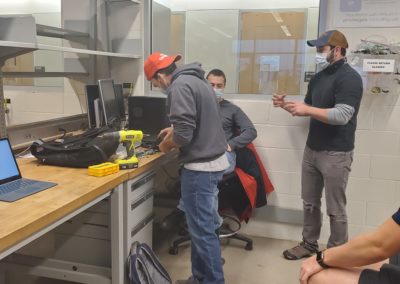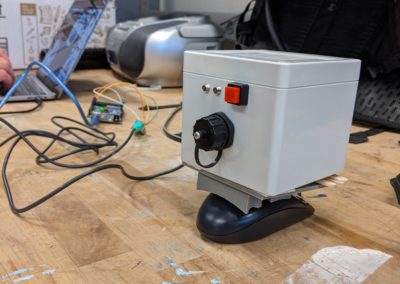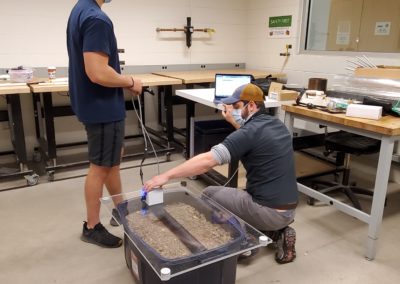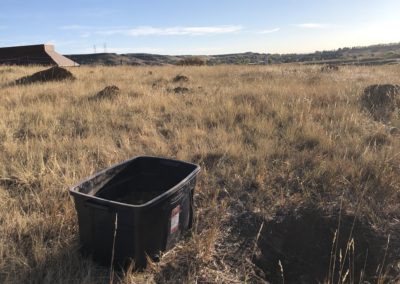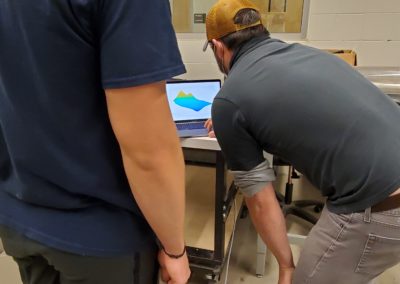Flowline Detection/Inspection Technologies
Overview
Our team has worked towards developing a state of the art flowline detection/inspection system to non-invasively assess the location and quality of abandoned flowlines. Flowlines are small diameter pipes used in the oil and gas industry that can cause serious problems when they are improperly abandoned such as the 2017 home explosions which killed two people and injured one in Firestone, CO. Since that incident, new regulations were passed which requires oil and gas operators to map the locations of these flowlines in order to prevent similar disasters in the future.
We attempted to use existing magnetic sensing technology to begin developing a system which would allow operators to easily meet these new regulations as well as save money from finding and fixing leaky pipes. It was determined that we would likely not be able to develop a full fledged system over the two semesters, so instead a proof of concept approach was taken in order to quantify what this future system might be capable of. We decided on using a triaxial magnetometer in order to sense the magnetic field of metallic pipes versus Earth’s natural magnetic field, with the vision that it can one day be implemented onto a drone which can perform quick field surveys.
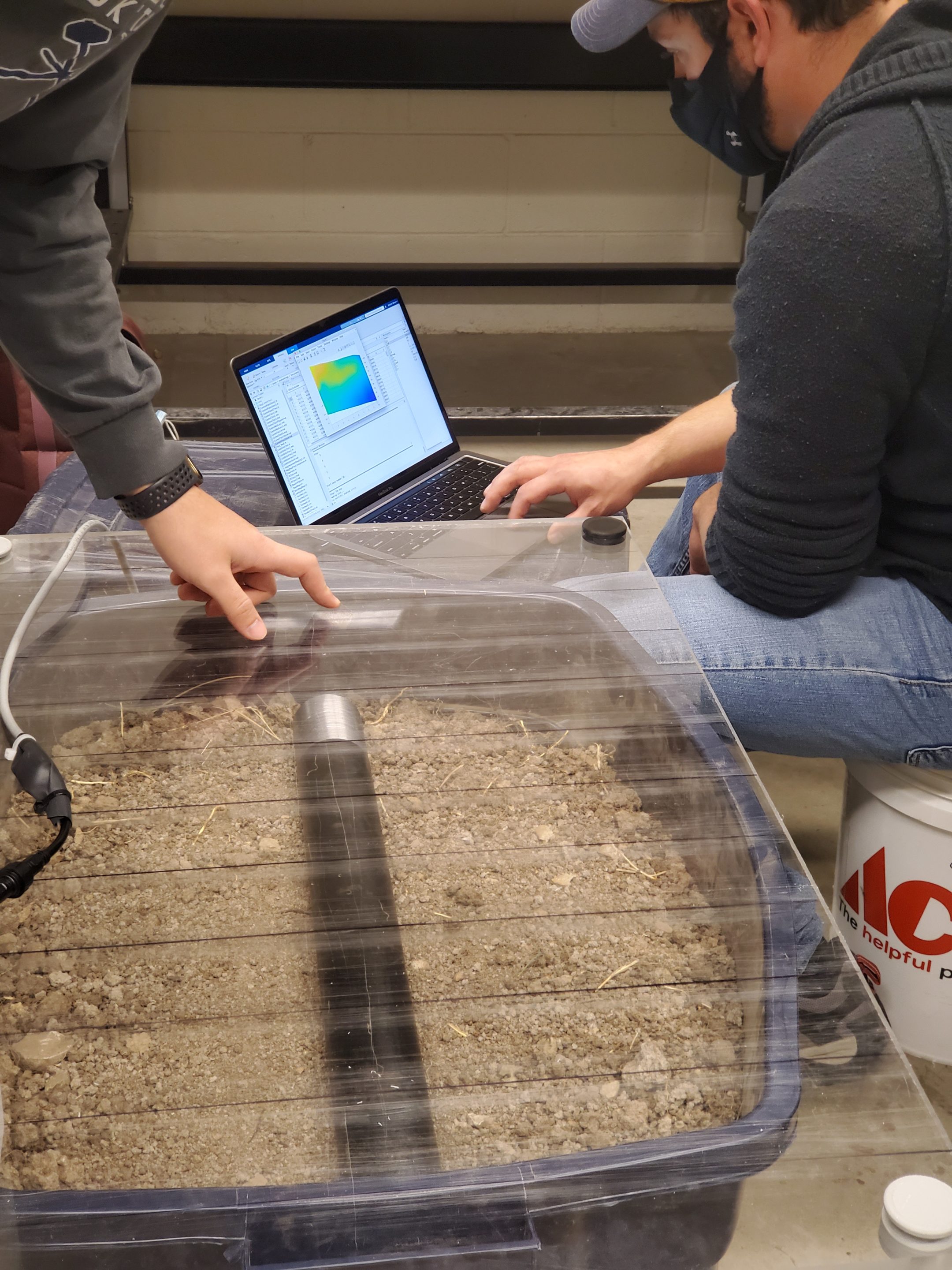
Andrew running a magnetometer scan on wall loss pipe failure condition.
Live Zoom Chat
Use the link below to join us live from 8:00 – 10:30 a.m. on December 3.
Join from PC, Mac, Linux, iOS or Android: https://mines.zoom.us/j/9477272725
Or iPhone one-tap: 16699006833,9477272725# or 13462487799,9477272725#
Or Telephone:
Dial: +1 669 900 6833 (US Toll) or +1 346 248 7799 (US Toll)
Meeting ID: 947 727 2725
International numbers available: https://mines.zoom.us/u/aoMyp0gWT
Team Members
- Andrew Hinga
- AV Schilt
- Benjamin Friedel
- Colin O’Connor
- Dane Tomei
- Preston Smith
The Client
- William Fleckenstein
Acknowledgements
Project Advisor: Emily Sievers
Technical Advisor: Emmanuel De Moore
Donations Made by: Mines Petroleum Engineering
Video
Elevator Pitch
Team Go With The Flow was asked to address the issue presented by unmapped or improperly abandoned subsurface flowlines that may be damaged and present a danger to their surroundings, such as the tragic accident that occured in Firestone, CO in 2017, where two people died from the gas leaking out of an improperly abandoned flowline which caused an explosion. The team’s goal was to develop a noninvasive methodology to detect these flowlines, obtain qualitative data about their condition, and incorporate this into a modular system that utilizes drone technology to inspect large sites.
The group designed a sensor system that utilizes a triaxial magnetometer in order to begin achieving these goals. Our simulation testing bed allows for easy system testing with different sensor positions, pipeline failures, pipeline depths, soil types, and pipelines with and without current. The group aims to test the magnetometer readings while changing these variables to validate its potential effectiveness. With this proof of concept, the group hopes to hand off this research to future Senior Design teams with the intent that this system might be implemented into a commercial product for real world applications.
Design Approach
To achieve our client’s goals, the team adopted a research and proof of concept design approach to this project. The team attempted to provide enough data from a single triaxial fluxgate magnetometer to show that a non-invasive and non-destructive procedure for detecting and inspecting flowlines is possible. Designing a system to run our experiments became a part of our final product so that experiments can continue to be carried out by future groups.
Three separate sensor and testbed concepts were designed. This included a high, medium and low budget concept for the sensor and a high in-ground, high out-of-ground, and low bathtub budget concept for the testbed. The team used decision matrices to determine which sensor and testbed concepts would best accommodate our design elements. This led to the decision of using the medium budget sensor, an FG-33+ triaxial fluxgate magnetometer with GPS module, and the inexpensive bathtub testbed. The testbed included a plexiglass table to monitor the position of the FG-33+ sensor, and an image of the testbed can be seen to the right.
Common flowline failure conditions needed to be tested which included flowlines with pitting, line strike, and wall loss. The team also needed to allow for flexibility in other flowline conditions per our client’s request. This included an electrical current test, iron oxide test, and soil type tests. Each of these conditions needed to be analyzed and studied to test the feasibility of a future system flagging these faulty conditions.
The FG-33+ sensor has a data logger and a serial user interface. This allowed for the team to have multiple options for collecting the sensor data. The team decided the best way to collect the sensor data was through the serial interface so that the data can be collected and analyzed in a single test. A MATLAB script was developed to interface with the controller of the FG-33+ sensor, collect data at timed intervals, and analyze the results. The team decided the best way to analyze the conditions of each experiment is visually through surface and contour plots.
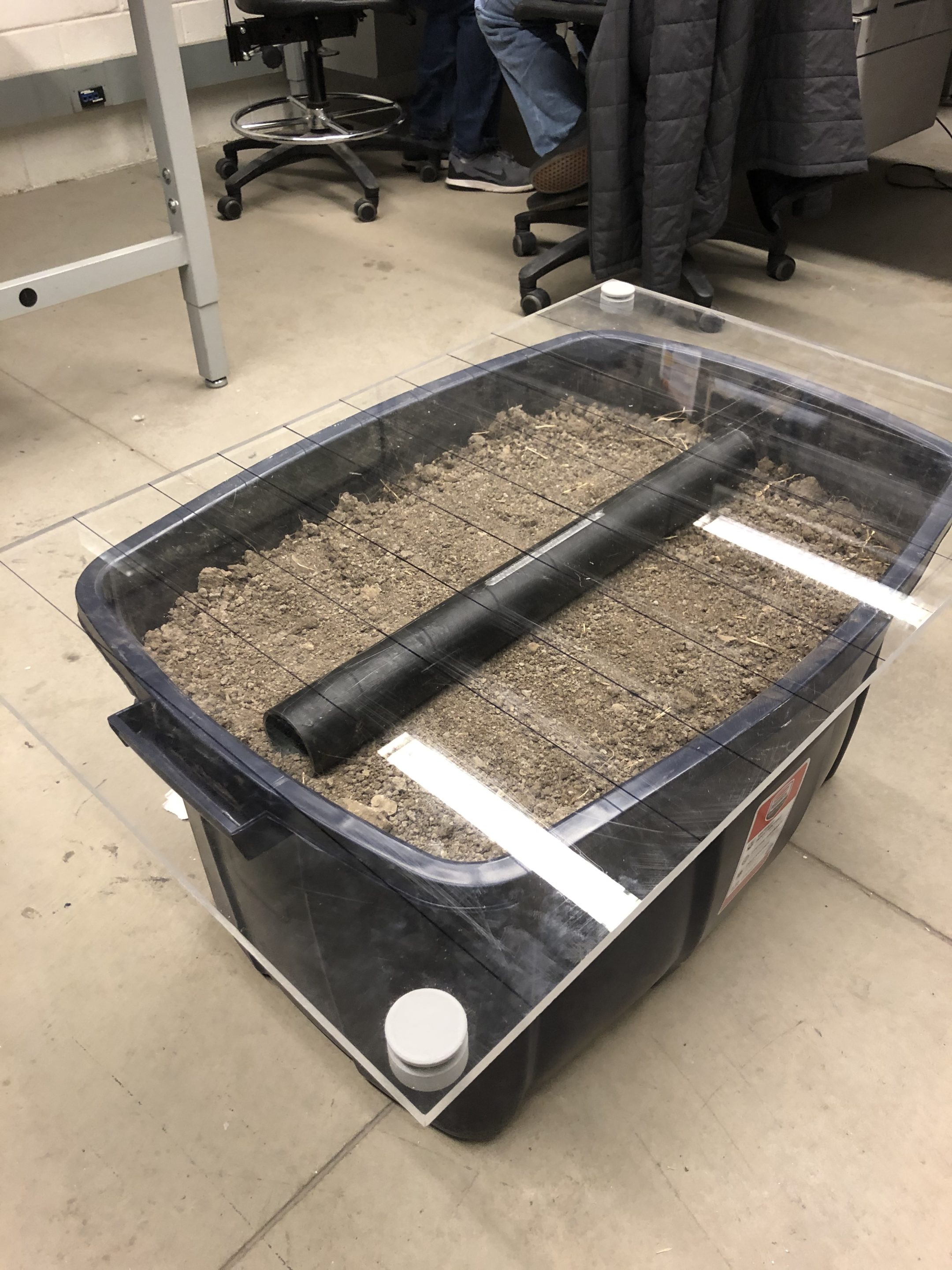
Design Solution
Each of the experiments were conducted using the constructed testbed and the FG-33+ sensor. The plexiglass table top was designed to have 3-inch spacings that guide the position of the sensor as each experiment is carried out. We took slices of magnetometer readings with a set number of samples so that the readings can be plotted to their XY-coordinates after each experiment is done.
In order to place the pipe in the testbed and imitate the conditions of each flowline failure type, the steel pipes needed to be cut to be 2-feet long and machined to a respective failure mechanism mentioned below. A 2-foot section of control pipe was also used to compare with each experiment. A list of how each condition was satisfied is shown below:
- Pitting condition: drilled a ¾ inch hole in the 2-foot section of steel pipe.
- Line strike condition: milled a 4-inch groove in the middle of a section of 2-foot steel pipe.
- Wall loss condition: lathed at 20%, 40%, and 80% wall loss in the middle of a section of 2-foot steel pipe.
- Current Test: Used a DC power supply to send current through the pipe at 50 mA, 500 mA, 1 A, and 5 A.
- Soil Test: Used samples of soil types found in Colorado in a smaller scale testbed to test the effects of soil type.
A total of 55 experiments were conducted, including the experiments that were conducted multiple times to verify results.
After the testing with the 2-foot section of pipe was completed, it was determined that the results had some complicating effects due to the small nature of our experimental setup. The team could not claim results to be proof of concept, but the results seemed promising enough to encourage future experimentation. It was difficult to determine the effects of some failures on the magnetometer readings for most of the failure mechanisms, but the results for the pitting condition turned out to be very promising as the effects on the magnetic field of the pipe seems large and easily detectable. This in addition to the fact that companies are already using similar magnetic sensors to detect flowlines already leads to the team foreseeing positive next steps for the project.
Next Steps
In order to continue this project, large scale testing needs to be done using this team’s findings as a solid foundation from which future groups can work off of. We ended up finding a lot of useful information, and with extra time, we could find valuable information which could possibly be incorporated into a commercial system.
It is our hope that our client moves forward with continuing our research, as we feel there is a lot of potential value to be had in the system we worked towards. We may not have had enough time to do it ourselves, but we feel that future work would result in a valid proof of concept which could eventually be transformed into a successful commercial product.
Meet the Team
Andrew Hinga
 My name is Andrew Hinga and I am graduating in December 2020 with my Bachelors of Science in Electrical Engineering with emphasis in antennas and wireless communications. I transferred to Colorado School of Mines from McHenry County College in Illinois in 2018. In January, I will be starting my first job as an RF Engineer I at Custom Microwave Inc. in Longmont Colorado. My tasks at CMi will include assisting in the design, manufacturing, and testing of high performance passive antennas and components such as waveguides, reflectors, horns, and feed networks for satellite communication systems. In my free time I enjoy playing the guitar, snowboarding, hiking, fishing, and spending time with my wife and kids. Being a part of Team Go With the Flow as the Signal Processing Lead has been a great experience for me and I have thoroughly enjoyed working with my fellow team members.
My name is Andrew Hinga and I am graduating in December 2020 with my Bachelors of Science in Electrical Engineering with emphasis in antennas and wireless communications. I transferred to Colorado School of Mines from McHenry County College in Illinois in 2018. In January, I will be starting my first job as an RF Engineer I at Custom Microwave Inc. in Longmont Colorado. My tasks at CMi will include assisting in the design, manufacturing, and testing of high performance passive antennas and components such as waveguides, reflectors, horns, and feed networks for satellite communication systems. In my free time I enjoy playing the guitar, snowboarding, hiking, fishing, and spending time with my wife and kids. Being a part of Team Go With the Flow as the Signal Processing Lead has been a great experience for me and I have thoroughly enjoyed working with my fellow team members.
Connect: www.linkedin.com/in/ahinga
Avery Schilt
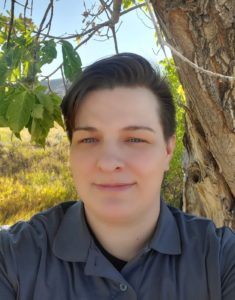 My name is Avery Schilt and I am graduating with my Bachelor of Science in Mechanical Engineering in December 2020. I transferred to Colorado School of Mines from Community College of Denver in 2018. I am a USMC veteran and have been involved with both the Mines Veterans Alliance and the Mine Rescue Team during my time here at Mines. In my remaining free time I also enjoy designing and fabricating props and costumes, gaming, hiking, and martial arts. Serving as a designer, fabricator, and budgetary project management assistant for Team Go With the Flow this past year has been an educational and rewarding experience. The team was faced with multiple challenges throughout the course of the year and has proven to be both capable and willing to pivot and adapt to every single one of them quickly and professionally. The lessons learned during the course of this project have been invaluable and it has been a pleasure to work with my team members for the duration.
My name is Avery Schilt and I am graduating with my Bachelor of Science in Mechanical Engineering in December 2020. I transferred to Colorado School of Mines from Community College of Denver in 2018. I am a USMC veteran and have been involved with both the Mines Veterans Alliance and the Mine Rescue Team during my time here at Mines. In my remaining free time I also enjoy designing and fabricating props and costumes, gaming, hiking, and martial arts. Serving as a designer, fabricator, and budgetary project management assistant for Team Go With the Flow this past year has been an educational and rewarding experience. The team was faced with multiple challenges throughout the course of the year and has proven to be both capable and willing to pivot and adapt to every single one of them quickly and professionally. The lessons learned during the course of this project have been invaluable and it has been a pleasure to work with my team members for the duration.
Connect: www.linkedin.com/in/avery-schilt-1286a1185/
Ben Friedel
 My name is Ben Friedel and I am graduating with a B.S. in Mechanical Engineering in December 2020. Before pursuing engineering, I spent some time in the academic world in organic synthesis and studying the genetics of cave crustaceans. After discovering a passion for industry and machinery my experiences have led me to work in chemical plants, offshore oil and gas, and large-scale tunnel boring. In my free time I enjoy playing golf, skiing, and caving, as well as listening to music and painting. It has been a pleasure serving as Team Lead for Team Go With the Flow. We have worked hard to improve our technical and project management skills to deliver actionable results under budget and on time. With today’s current setbacks and challenges it was only possible with the creativity and hard work of my teammates and advisors – thank you.
My name is Ben Friedel and I am graduating with a B.S. in Mechanical Engineering in December 2020. Before pursuing engineering, I spent some time in the academic world in organic synthesis and studying the genetics of cave crustaceans. After discovering a passion for industry and machinery my experiences have led me to work in chemical plants, offshore oil and gas, and large-scale tunnel boring. In my free time I enjoy playing golf, skiing, and caving, as well as listening to music and painting. It has been a pleasure serving as Team Lead for Team Go With the Flow. We have worked hard to improve our technical and project management skills to deliver actionable results under budget and on time. With today’s current setbacks and challenges it was only possible with the creativity and hard work of my teammates and advisors – thank you.
Connect: www.linkedin.com/in/bdfriedel/
Colin O'Connor
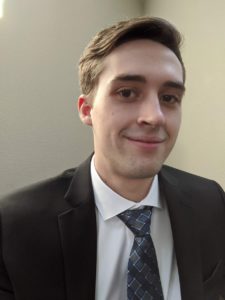 My name is Colin O’Connor, and I will be graduating with a M.S. in Environmental Engineering in Spring 2021. I enjoy engineering and all things to do with nature, and I am looking for an environmental consulting position when I graduate in the Summer. It has been a pleasure to be here at Mines and work as the Scrum Master for this Senior Design Team. I have learned a lot about regulations and engineering fields unfamiliar to me, and working with such a capable team of diverse engineers taught me a lot about delegating responsibility and communicating efficiently. My time at Mines was a pleasure, and I am eagerly looking forward to the next chapter of my life!
My name is Colin O’Connor, and I will be graduating with a M.S. in Environmental Engineering in Spring 2021. I enjoy engineering and all things to do with nature, and I am looking for an environmental consulting position when I graduate in the Summer. It has been a pleasure to be here at Mines and work as the Scrum Master for this Senior Design Team. I have learned a lot about regulations and engineering fields unfamiliar to me, and working with such a capable team of diverse engineers taught me a lot about delegating responsibility and communicating efficiently. My time at Mines was a pleasure, and I am eagerly looking forward to the next chapter of my life!
Connect: www.linkedin.com/in/colinoco
Dane Tomei
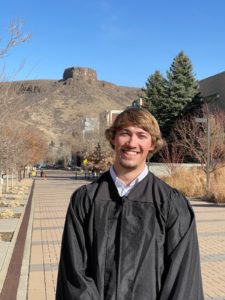 My name is Dane Tomei and I am a Civil Engineering student graduating in December, 2020. After I graduate I will be working for EST Inc, a design-build firm in Denver, CO. There I will be a structural engineer working on steel bridge design, roadway design, hydraulic design, and vertical design. I have had the pleasure of working with the flowline team as a designer and construction manager. This project has given me many opportunities that have exposed me to new types of design for utilities and flowlines.
My name is Dane Tomei and I am a Civil Engineering student graduating in December, 2020. After I graduate I will be working for EST Inc, a design-build firm in Denver, CO. There I will be a structural engineer working on steel bridge design, roadway design, hydraulic design, and vertical design. I have had the pleasure of working with the flowline team as a designer and construction manager. This project has given me many opportunities that have exposed me to new types of design for utilities and flowlines.
Connect: www.linkedin.com/in/danetomei/
Preston Smith
 My name is Preston Smith and I will be graduating with a B.S. in Mechanical Engineering in December 2020. My previous work experiences include summers at PPG Aerospace, Strand Products, and Edel Golf. Outside of school and work, I have spent the last four years competing on the Mines Varsity Golf Team, as well as serving as a playing captain the last two seasons. Working with Team Go with the Flow as communications lead for the past two semesters has been remarkable. The team has worked hard in order to produce deliverables within the budget and time constraints, given the circumstances, this is something that the team is proud of.
My name is Preston Smith and I will be graduating with a B.S. in Mechanical Engineering in December 2020. My previous work experiences include summers at PPG Aerospace, Strand Products, and Edel Golf. Outside of school and work, I have spent the last four years competing on the Mines Varsity Golf Team, as well as serving as a playing captain the last two seasons. Working with Team Go with the Flow as communications lead for the past two semesters has been remarkable. The team has worked hard in order to produce deliverables within the budget and time constraints, given the circumstances, this is something that the team is proud of.
Connect: www.linkedin.com/in/preston-smith-94236714b/

